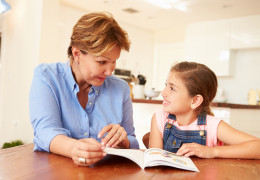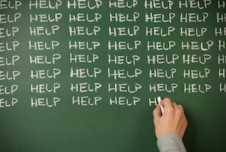The COVID-19 crisis is forcing educational professionals across the globe to take a collective breath. What’s next? Whether we’re actively planning online lessons from our homes or bingeing more Netflix movies than we had ever anticipated, we’re faced with so many unknowns—and more time to sit with our emotions.

We may feel overwhelmed, fearful, and emotionally fragile. Perhaps also restless, bored, and helpless. With so much uncertainty, how can we navigate this range of emotions? After all, researchers remind us that our stress-management skills ultimately help our students (and those around us) stay calmer.
Here are a few simple and easy-to-implement practices that you can draw on to manage difficult emotions.
Soothe yourself
Begin by acknowledging the emotions you are experiencing right now and genuinely offer yourself some understanding. Researchers Kristin Neff and Chris Germer invite us to take a moment for what they call a “self-compassion break”—a gentle, reassuring practice that you can try any time in your day when you feel particularly overwhelmed, discouraged, or frustrated. For what it’s worth, I practice it all the time—and my teenage daughter finds it reassuring and calming, as well.
First, tell yourself, “This thing I’m dealing with is tough.” (Or “This is a moment of suffering,” or whatever words feel natural to you.) The idea is to “hold with” the moment of emotional pain, be with it, and accept that it is happening.
Second, acknowledge that you are not alone in your suffering. “So many teachers (and other human beings on this globe) face this same sense of overwhelm I’m experiencing right now.” The idea here is to recognize your “common humanity,” so that you feel less isolated in your pain—and ultimately more connected to others.
Third, offer yourself some kind or compassionate words—and even a soothing gesture or touch (like placing a hand on your heart). As humans, we are wired to respond positively to calming voices and gentle touch. Again, use your own style here. You might say, “May I be kind to myself today” or “May I be especially gentle with myself today.”
If you’re interested in deepening your practice of self-compassion, you might also try writing a self-compassionate letter, listening to this mindful self-compassion practice, or even taking a self-compassion course specifically designed for educators.
Affirm your values and strengths
What if restlessness and cynicism seem to prevail, and you don’t feel effective in your work—or lack thereof? It’s crucial to keep coming back to “what matters” most to you, again and again. And, more importantly, to seek opportunities to enact your values in small ways each day.
One way to give yourself a little boost is to reaffirm your values. Where do you want to place your attention and energy—right now? On beauty, humor, spontaneity, curiosity, creativity, connection? What feeds you? You can draw on this Affirming Your Important Values exercise to reorient in the moment. According to one study, affirming your values when you’re feeling helpless can help protect your mood.
Having a guiding light is helpful, but so is making a concrete plan. Try this Use Your Strengths exercise where you choose a personal strength—such as courage, teamwork, or humor—consider one simple way you might use it each day for a week, and then act on your idea whenever the opportunity arises.
For example, you might see “perseverance” as a personal strength and value. How might you model that strength through your contact with students, colleagues, and family members? Perhaps you could share quotes and notes of encouragement that highlight this value, host a daily ritual that children and families can rely on—like an online read-aloud—or feature stories of perseverance in your online history course. Research suggests that identifying and using your strengths daily for only one week may actually increase your happiness and help stave off symptoms of depression.
Send good wishes to others
Of course, there may be times during this crisis when it becomes more challenging to tap your strengths and values. At one point in my teaching career, I woke up every day with a visceral sense of dread. Despite my commitment to my students, preparing to face them required intense mental effort each morning.
Here’s one simple way I found a sense of comfort and hope. I pulled into the parking lot, looked over at the building, and mentally sent good wishes to myself, my students, and my colleagues: “May I/you be safe; may I/you be happy; may I/you be healthy; may I/you live with ease.” Simply infusing this way of thinking into my daily interactions bolstered me as I confronted the more difficult aspects of my job and life circumstances. Your “parking lot” may now be your living room, and your laptop screen may be your “building,” but the sentiment remains the same.
This brief practice (called “loving-kindness”) is one of the most effective ways for increasing our empathy and compassion for others. Studies indicate that people who practice loving-kindness for just a few weeks can experience more self-compassion and positive emotions, and relief from depression, anxiety, and chronic pain.
If you would like to try more formal versions of this practice, here is a loving-kindness practice and a practice called Imagining Flourishing and Kindness.
Consider mindfulness as a way of being
Mindfulness, broadly speaking, is another form of kindness. It’s taking time—right now—to simply be with your thoughts and feelings. No judgment necessary. I can be aware of my mental chatter and intense emotions, and I can also practice openness and curiosity as I observe my ever-changing internal world.
When I started teaching over 25 years ago (pre-mindfulness practice!), I would sometimes steal away from the stress at lunchtime, close my door for five minutes, turn off the lights, and lie on my back—calming my overstimulated mind and body. I was caught up in the needs, lives, and stories of my 163 ninth and tenth graders, and I knew the best thing I could do for myself was to stop and just “be” for a moment, before re-engaging with those kids I loved. Over time, mindfulness is becoming more of a way of being as I learn to infuse lots of mini-practices into my days—not just when I wake or before I sleep.
For example, this Three-Minute De-Stressor for Teachers can be incorporated throughout the day—whether you are with your students, pausing between classes, or chatting with a colleague. Simply stand, find the center of gravity in your abdomen (two inches below your navel and about an inch into your body), and focus on this point while feeling your feet solidly on the ground.
There are also a number of different breath practices you can try—box or square breathing or counting breaths, for example. It’s particularly important to simply practice extending the outbreath (activating your parasympathetic or “rest and digest” nervous system) more than the inbreath (your sympathetic “fight or flight” nervous system) to rebalance.
And if you’re gearing up for a difficult conversation with a parent or facing a challenging staff meeting, you can draw on this brief practice for relaxing tense and anxious bodies: The CALM Reminder. Mindfulness researchers Chris Willard and Randye Semple prompt us to check in with our chest (C), arms (A), legs (L), and mouth (M)—first noticing sensations in those areas, and then tensing and relaxing each set of muscles, in sequence.
Although we face a time of great uncertainty and a challenging mélange of emotions, we can draw on multiple tools to help us pause, be with those emotions, and redirect them. If we practice taking healthy “timeouts” on our own, we are more likely to model and share these rituals with our students, colleagues, and family members. Let’s commit to practicing self-care each day so that we can move forward together with a greater sense of ease, purpose, and kindness.









Comments